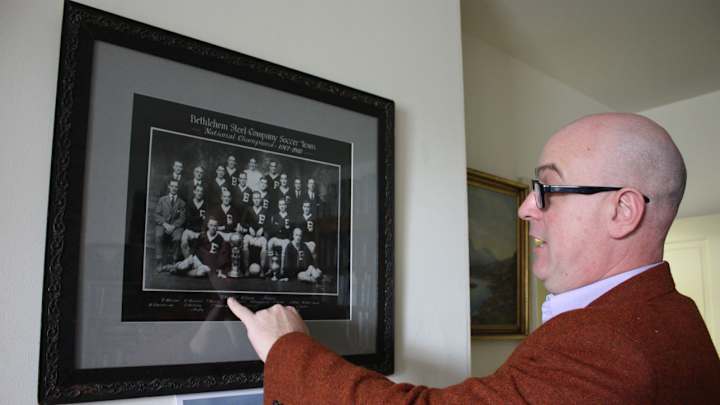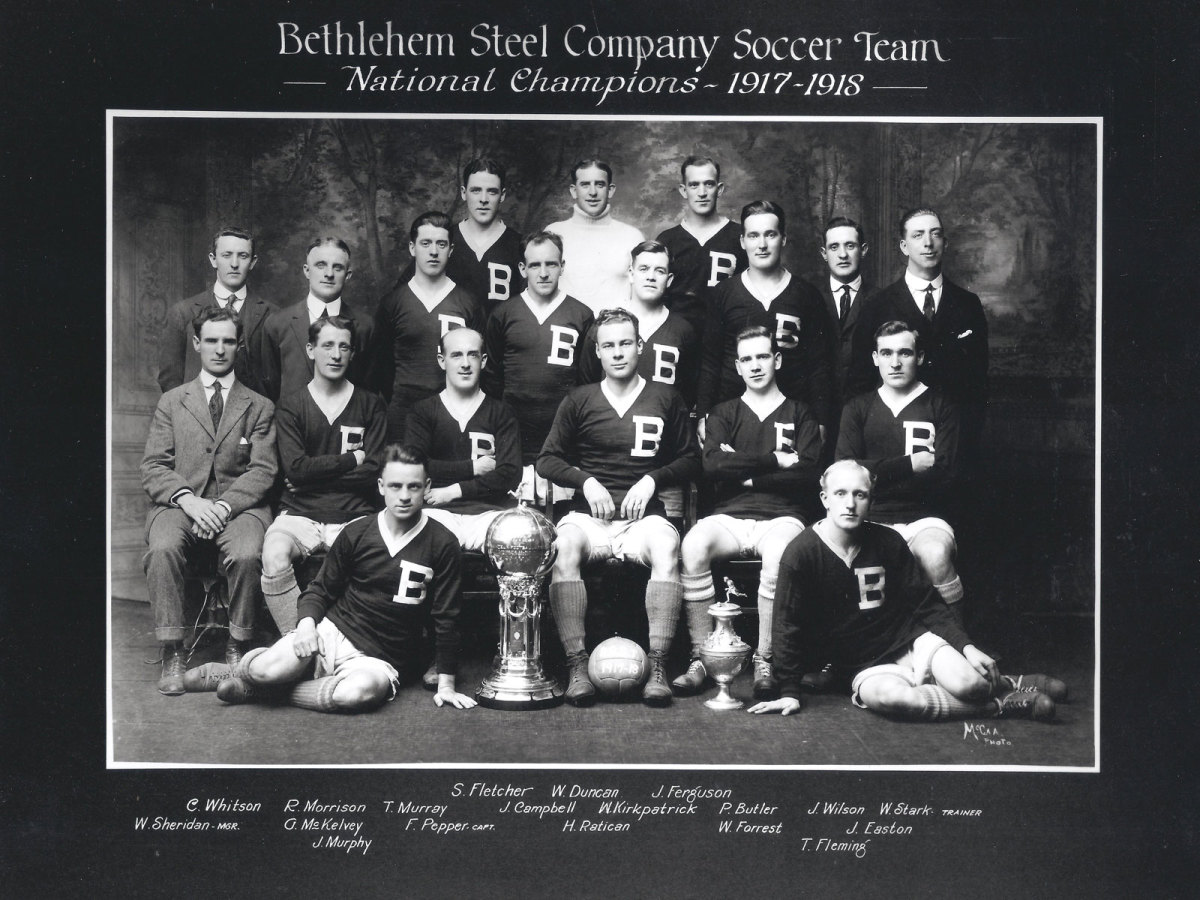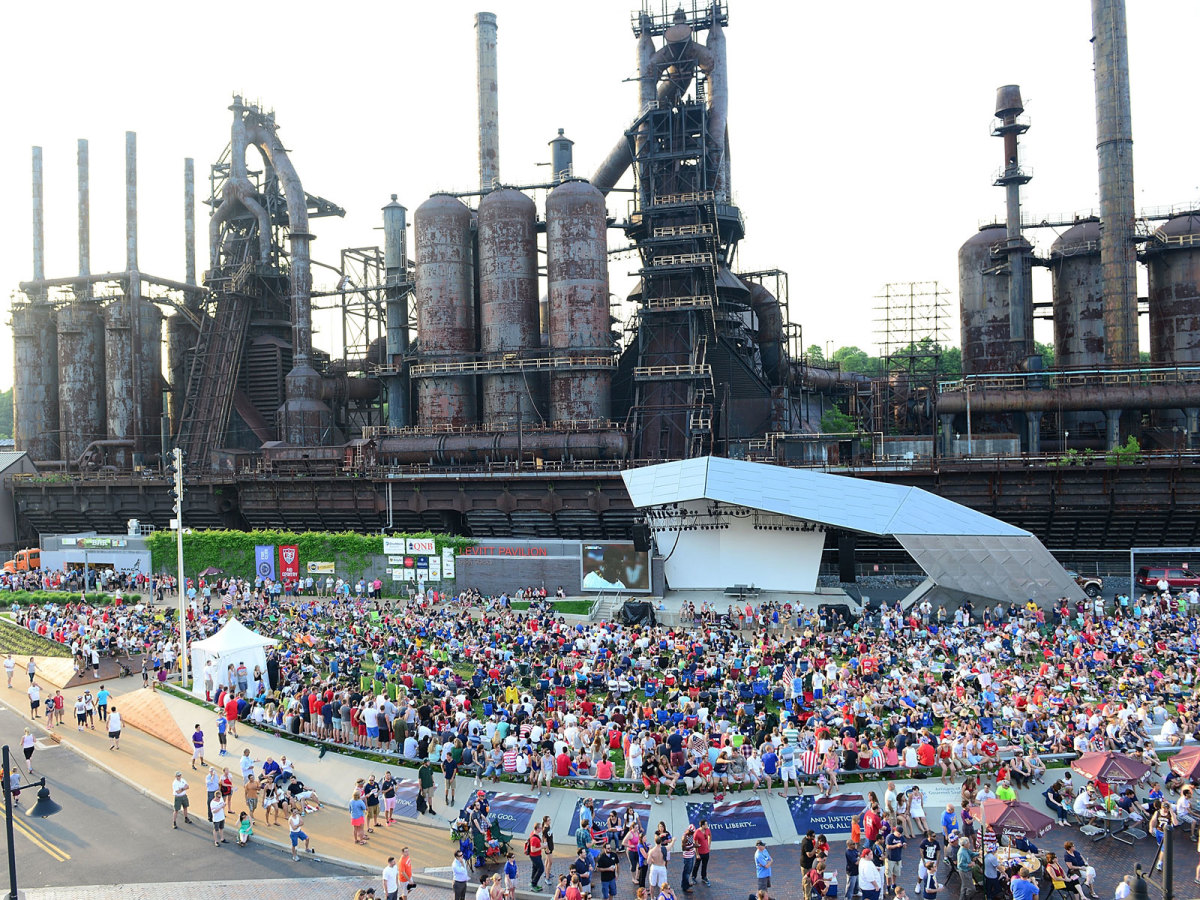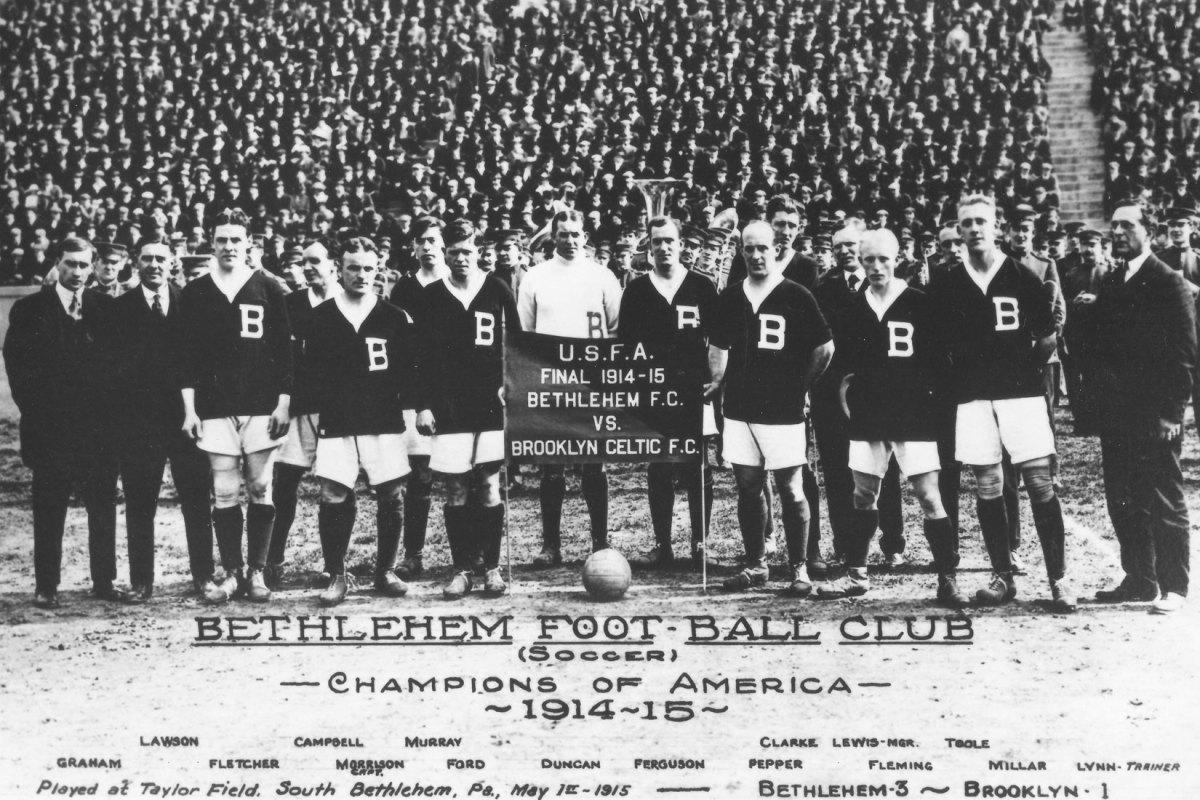Pastor Keeps History of Storied U.S. Club Bethlehem Steel Alive

Until a few years ago, one of America’s most successful soccer clubs had been reduced to whispers.
For decades, the story of the Bethlehem Steel Soccer Club had been passed down mostly by word of mouth, the descendants of players vaguely aware that their ancestors had played for a soccer team in Pennsylvania’s Lehigh Valley. A handful of American soccer historians knew about the club, which had folded in 1930 just before the original American Soccer League collapsed. But the stories of Bethlehem Steel’s former glory had faded with time.
Go to Bethlehem today, however, and you’ll find another team bearing the former club’s name, Bethlehem Steel FC, a USL affiliate of the Philadelphia Union. You might see someone walking around the repurposed SteelStacks, the old Bethlehem Steel Corporation’s giant blast furnaces, wearing a Mitchell and Ness Bethlehem Steel T-shirt. The resurgence of interest in Eastern Pennsylvania’s soccer heritage over the last several years has been meteoric, fueled in part by the Union’s earnest desire to reconnect with the state’s soccer roots.
But we owe almost everything we know about the original Bethlehem Steel Soccer Club to a Pennsylvania pastor named Daniel Paul Morrison.

Morrison, 56, is the pastor at Huntingdon Valley Presbyterian Church, just outside Philadelphia. Despite having no formal association with soccer, he’s also a sort of unofficial historian of the Bethlehem Steel Soccer Club. And without his research, it’s possible the story of soccer in Bethlehem would have never been fully told.
“I can’t think of anybody with no prior connection to the sport who has gotten involved in studying the history to the extent that Dan has,” says former National Soccer Hall of Fame historian Roger Allaway, whose book Corner Offices & Corner Kicksis based in part on Morrison’s research.
Growing up, Morrison was vaguely aware that two of his great uncles, Bobby and Joe, played for a soccer team in Bethlehem. Around 1998, four years before he entered seminary, he grew curious about his ancestors, but nobody had written anything about the team. The club featured prominently in soccer historian Colin Jose's 1998 seminal history of the original American Soccer League, but the team's full story hadn’t been told. Upon realizing his uncle Bobby was one of the early inductees into the National Soccer Hall of Fame, Morrison started digging deeper. The Bethlehem Steel Soccer Club, he realized, was much more than family mythology.
Originally founded as the Bethlehem Football Club, the team changed its name in 1915 when Bethlehem Steel, one of America’s largest steel producers and shipbuilders, formally took over the club’s operations. The team was already comprised of employees. Headquartered in the iron-rich Lehigh Valley, the Bethlehem Steel Corporation employed thousands of people, including numerous European immigrants. The company’s steel helped build the Empire State Building, Chrysler Building, Golden Gate Bridge and Hoover Dam. It supplied Allied forces with armor plate and other combat supplies during World War I and World War II.
Aside From the Trophy, What Else Can USA Take Away From 2017 Gold Cup?
With backing from one of the biggest corporations in America, the club had the resources to spend ambitiously. The immigrants who played for the Bethlehem Steel Soccer Club were Anglo-Saxon, recruited from the United Kingdom by the club to play in America, where they could make better money by playing for the club and working for the company. (Morrison’s great uncles came from Scotland.) Many immigrants happened to play club soccer in America, but this was different: These individuals were specifically recruited to be soccer players. When we think of foreign stars coming to the U.S. to play soccer, Pele and David Beckham come to mind. But the importing of foreign talent was a major component of the success of American Soccer League clubs like Bethlehem Steel and the Fall River Marksmen, based in Massachusetts.
Bethlehem Steel obliterated most of its competition—Morrison argues they’re the best American team of the era—and racked up titles, including five U.S. Open Cups (then called the National Challenge Cup), still tied for a record. The club won 10 league championships in 15 seasons between 1912 and 1927, and 11 players from the team are enshrined in the National Soccer Hall of Fame. But the club folded in 1930 because of financial problems, and the original American Soccer League collapsed soon after following the “soccer war,” which pit the U.S. Football Association against the American Soccer League in a self-immolating dispute over control of the sport. The dark ages of American soccer followed. But beyond the pitch, the boom and bust of Bethlehem Steel’s soccer team embodied early 20th century America—particularly the country’s growing industrial might, fueled by immigrants trying to find their way in a new country.
FC Cincinnati Edges Miami FC in Tense, All-Lower-Tier U.S. Open Cup Quarterfinal
Morrison didn’t set out to become the world’s leading expert on the Bethlehem Steel Soccer Club. But his curiosity about his family gave way to genuine interest, which turned into obsession. He started driving two hours, round trip, on weekends, family in tow, from Doylestown, Pa., where he had recently moved, to Bethlehem’s public library, where he would sift through microfilm of old BethlehemGlobe–Times news clippings.
“For him, it’s a chase,” Morrison’s wife, Eva, says. “It’s an intellectual chase but it’s also physical, because he tends to like to go there.”
He’d sit for hours at a microfilm reader, winding a crank to scroll through reels, hoping to catch a mention of Bethlehem Steel’s team. When he found an article of interest, like a game recap or column, he’d print it out. He would return home with a small stack of news clippings and transcribe them that night onto his website, which he had created so that he could search his own collection and so that people connected to the club could contact him. His website ultimately digitized the team's history. If necessary, he’d drive to other public libraries around the Northeast to hunt down information about a game that the Bethlehem paper didn’t cover. After more than three years and countless hours, he had transcribed and republished around 3,000 articles on Bethlehem Steel.
“They say the newspaper is the first draft of history, and this is a story where nobody had bothered to write a second draft,” Morrison says. “So my job was to write a second draft of this and to begin to put together that story and excavate it.”
Reading about games that happened in the early 20th century might sound boring. But Morrison was enthralled, especially after he started reading chronologically. Never a big sports fan, Morrison finally understood the emotional appeal of a season’s narrative: With no detailed public information about the team available anywhere, he was in suspense, unaware of game outcomes and unsure how a season would end. He would worry for players, and speculate about how the team would fare in an upcoming match. Never mind that the game had been settled nearly a century earlier.

As Morrison read newspaper accounts of the team, he started to feel like he knew the players personally. He became emotionally invested in their lives, a sensation that grew when he started interviewing relatives of players and coaches, including the widow of his Uncle Joe. Conversations with players’ relatives could be clarifying. He once read a vague newspaper reference to a legal disturbance involving a player. During one of his interviews, he learned that the player had run off with the coach’s wife.
“You read 3,000 articles about a club and you feel like you know the guys at some point, at least the main characters. There are some more marginal characters that come and go, but you end up feeling like you know them,” Morrison says. “And you kind of hate to see the season end.”
He also scoured flea markets and trade shows, hoping to find Bethlehem Steel memorabilia, mystifying traders unaccustomed to interest in soccer paraphernalia. His collection includes old medals, photos and other rare artifacts from the period.
Morrison is an unlikely soccer historian. For one, when he started the project, he had never watched a soccer game. Even as he mined through the library’s archives, he didn’t know what a corner kick looked like, until he finally attended a D.C. United game with a friend. He was amazed by soccer’s rhythm and unpredictability, and how a scoring chance could arise from nothing.
He’s also not, of course, a full-time historian. Morrison entered seminary in 2002, when he was 40, after working as a journalist, copywriter and teacher, collecting a few degrees along the way. He grew up in a religious family, and he ultimately felt a calling to go into the ordained ministry. Morrison is professorial but incredibly affable, easily amused by colorful tales uncovered in his research. He also has a unique ability to speak with authority about a perplexingly eclectic range of subjects.
“There are a few little domains in which I am the one person in the world who knows the most,” Morrison says. “[Bethlehem Steel] is one of them.”
LAFC sets out to create the MLS 3.0 standard
Morrison’s expertise, in other words, is hardly limited to Lehigh Valley soccer. He is the general secretary of the North American Araucanian Royalist Society, the self-declared preeminent English-language authority on the Kingdom of Araucania and Patagonia, an 19th century unrecognized state in South America. He has published three volumes of collected works of a British detective novelist named E. Phillips Oppenheim, and he’s working on a volume about another British detective writer, Arthur Morrison (no known relation). He also wrote a memoir of his uncle’s experience in World War II, and he has taken a keen interest in American Regionalism, a mid-20th century Midwestern artistic movement. He collects art from Greenland.
“He is the typical renaissance man. He just wants to know more about everything,” his daughter Rosie, 25, says. “I think with all of his research projects, there was something that caught his interests and then he dove.”
Adds his 23-year-old son Calvin: “He’s always got something kicking.”
Morrison planned to write a social history of Bethlehem Steel, but he pushed it aside when he entered seminary in 2002. Still, he’s the club’s de facto historian, and his monopoly on Bethlehem Steel history was such that Allaway felt compelled to ask him for permission before writing his book about the club.

Morrison has become a go-to soccer expert, particularly in Eastern Pennsylvania. During the 2014 World Cup, Morrison was invited to lecture about Bethlehem Steel at an official viewing party at SteelStacks in Bethlehem. He has also addressed the Sons of Ben, the Philadelphia Union supporters club, about Pennsylvania’s soccer heritage. He helped carry the trophy onto the field at the 2014 U.S. Open Cup final, when the Union lost to the Seattle Sounders. When Lionel Messi scored his 71st goal of the 2011-12 season, surpassing former Bethlehem Steel star Archie Stark’s previous single-season record of 70 goals scored in 1924-25, Morrison fielded calls from European journalists looking for comment.
That a man like Morrison could become the de facto historian of such a storied club might seem puzzling. But it’s indicative of soccer’s unique place in American sports culture. Soccer doesn’t have the institutional backbone in America of other sports, like baseball or football. Major League Soccer is less than 25 years old, and other leagues have come and gone, generating some interest before fizzling out or falling into financial ruin. There’s a small group of American soccer historians, like former National Soccer Hall of Fame historians Allaway and Jose, but there’s a lot of ground to cover.
Soccer’s future in America is a subject of great speculation, but the sport’s past in this country is incredibly overlooked and misunderstood. American soccer didn’t “arrive” with the 1999 Women's World Cup triumph or the 1994 World Cup or when Pele showed up in the 70s. It precedes the USA’s legendary upset of England at the 1950 World Cup. It started long before even the 1930 World Cup team’s third-place finish. Relatively forgotten for so many years, soccer’s early history in America—especially in the 1920’s, before the ASL collapsed—was a sort of golden age for the sport, and the story of Bethlehem Steel was just one piece of that narrative.

It’s not often that a research project ends with the subject coming back to life. But that’s essentially what happened with Bethlehem Steel. Beginning in 2013, the Philadelphia Union started honoring its Pennsylvania ancestor with special kits and jersey patches, paying tribute to Bethlehem in two U.S. Open Cup finals. When the MLS club decided to establish a USL affiliate in the Lehigh Valley, fans overwhelmingly voted to name the new club Bethlehem Steel FC.
“Living in the past in sports is dangerous, but the future is tied to the past. I think it’s a really, really important piece of it. It’s important to the fans, and it’s important to respect the community that wrapped its arms around Bethlehem Steel in the past,” former Union CEO Nick Sakiewicz says. “And the most important thing is there’s no marketing scheme, or no marketing dollars that you could spend to develop that. That’s history. That’s history that was made and created by those people, and that is priceless.”
The modern Bethlehem Steel FC played its first game on March 25, 2016—86 years after the original club shuttered and 18 years after Morrison began his research.
“To me, it was very gratifying to see people become more aware of the history around them,” Morrison says.
Morrison has yet to attend a match–“Sundays are tough for me,” he shrugs–but the soaring appreciation for Bethlehem Steel in the American soccer community remains surreal to him.
Bethlehem Steel’s reincarnation isn’t a direct continuation of the club that dominated the American Soccer League in the early 20th century. But it suggests a growing determination to bridge soccer’s forgotten past with its unknown future, in the Lehigh Valley and beyond, moving the sport into a new chapter by embracing the old. That’s something worth remembering.
